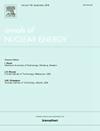Loss-of-heat-sink transient simulation with RELAP5/Mod3.3 code for the ATHENA facility
IF 1.9
3区 工程技术
Q1 NUCLEAR SCIENCE & TECHNOLOGY
引用次数: 0
Abstract
ATHENA (Advanced Thermal-Hydraulic Experiment for Nuclear Applications) is a large multipurpose pool-type lead-cooled facility under construction at the Mioveni site in Romania. It has been identified by the FALCON (Fostering ALfred CONstruction) Consortium to characterize large to full-scale ALFRED components, to conduct integral tests, and to investigate the main thermal–hydraulic phenomena inherent in pool-type systems. ATHENA is representative of ALFRED in terms of the difference in height of the thermal barycenters of the heat source and heat sink, i.e., 3.3 m, in order to reproduce the buoyancy forces in the system. Similar to ALFRED’s design, ATHENA minimizes thermal stratification within the main vessel even under natural circulation conditions, through an internal structure referred to as “barrel”. This structure directs the fluid flow towards the main vessel, preventing fluid stagnation near the vessel itself. The paper initially provides a steady-state thermal–hydraulic characterization of the facility, including details of the numerical model developed using the RELAP5/Mod3.3 thermal–hydraulic code. Then, focus is given to the transient analysis considering as a reference scenario a Loss-of-Heat-Sink (LOHS) accidental transient. In this scenario, the Main Circulation Pump (MCP) is assumed to remain operational while the Core Simulator (CS) is deactivated once the lead temperature at the Main Heat Exchanger (MHX) outlet reaches a predefined threshold. A sensitivity analysis is conducted with set points of 430 °C, 450 °C, 470 °C, and 490 °C, assessing the system’s response following MHX isolation from the secondary loop. The study evaluates the impact of different CS deactivation set points on reactor SCRAM delay (reducing CS power to a level representative of decay heat) as well as on system maximum and minimum temperatures.
使用 RELAP5/Mod3.3 代码对 ATHENA 设施进行散热损失瞬态模拟
ATHENA(核应用先进热工水力实验)是一个大型多用途池式铅冷设施,正在罗马尼亚米奥韦尼建造。FALCON(促进 ALFRED 建设)财团已确定将其用于鉴定大型乃至全尺寸 ALFRED 组件,进行整体试验,并研究池式系统固有的主要热-水力现象。为了再现系统中的浮力,ATHENA 在热源和散热器的热原点高度差(即 3.3 米)方面具有 ALFRED 的代表性。与 "阿尔弗雷德 "号的设计类似,即使在自然循环条件下,"阿塔纳 "号也能通过一种被称为 "桶 "的内部结构,最大限度地减少主容器内的热分层现象。这种结构将流体流向主容器,防止容器附近的流体停滞。本文首先介绍了该设施的稳态热工水力特性,包括使用 RELAP5/Mod3.3 热工水力代码开发的数值模型的细节。然后,重点介绍瞬态分析,将热沉损失(LOHS)事故瞬态作为参考情景。在这种情况下,假定主循环泵(MCP)保持运行,而一旦主热交换器(MHX)出口处的导线温度达到预定阈值,堆芯模拟器(CS)就会停用。对 430 ℃、450 ℃、470 ℃ 和 490 ℃ 设定点进行敏感性分析,评估 MHX 与二次回路隔离后的系统响应。研究评估了不同的希尔思停用设定点对反应堆 SCRAM 延迟(将希尔思功率降至衰变热量的代表水平)以及系统最高和最低温度的影响。
本文章由计算机程序翻译,如有差异,请以英文原文为准。
求助全文
约1分钟内获得全文
求助全文
来源期刊

Annals of Nuclear Energy
工程技术-核科学技术
CiteScore
4.30
自引率
21.10%
发文量
632
审稿时长
7.3 months
期刊介绍:
Annals of Nuclear Energy provides an international medium for the communication of original research, ideas and developments in all areas of the field of nuclear energy science and technology. Its scope embraces nuclear fuel reserves, fuel cycles and cost, materials, processing, system and component technology (fission only), design and optimization, direct conversion of nuclear energy sources, environmental control, reactor physics, heat transfer and fluid dynamics, structural analysis, fuel management, future developments, nuclear fuel and safety, nuclear aerosol, neutron physics, computer technology (both software and hardware), risk assessment, radioactive waste disposal and reactor thermal hydraulics. Papers submitted to Annals need to demonstrate a clear link to nuclear power generation/nuclear engineering. Papers which deal with pure nuclear physics, pure health physics, imaging, or attenuation and shielding properties of concretes and various geological materials are not within the scope of the journal. Also, papers that deal with policy or economics are not within the scope of the journal.
 求助内容:
求助内容: 应助结果提醒方式:
应助结果提醒方式:


